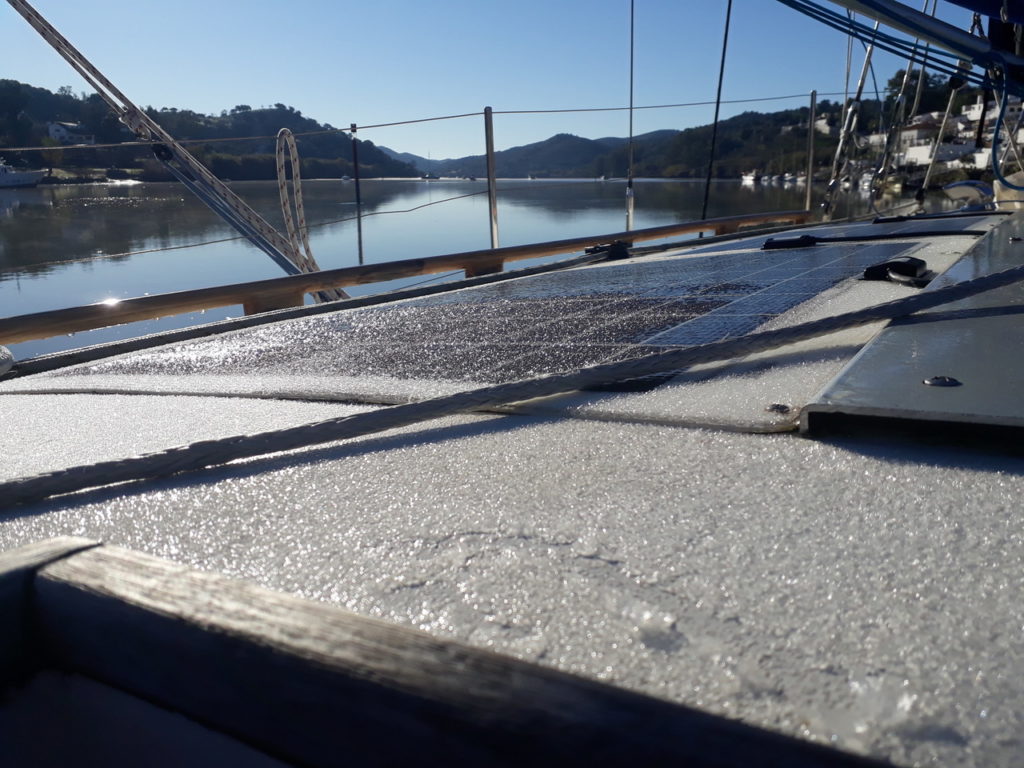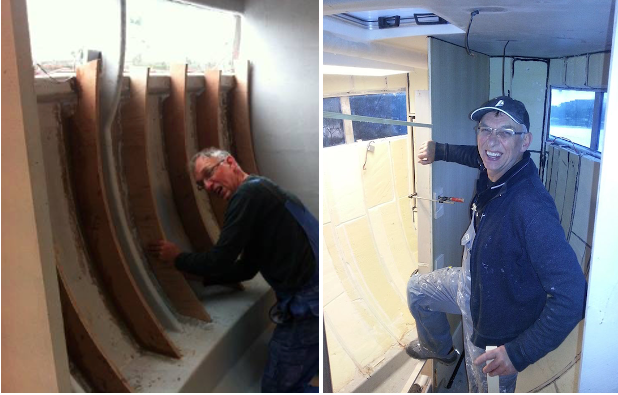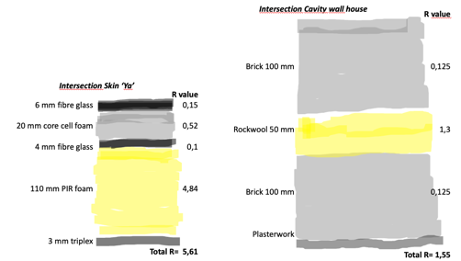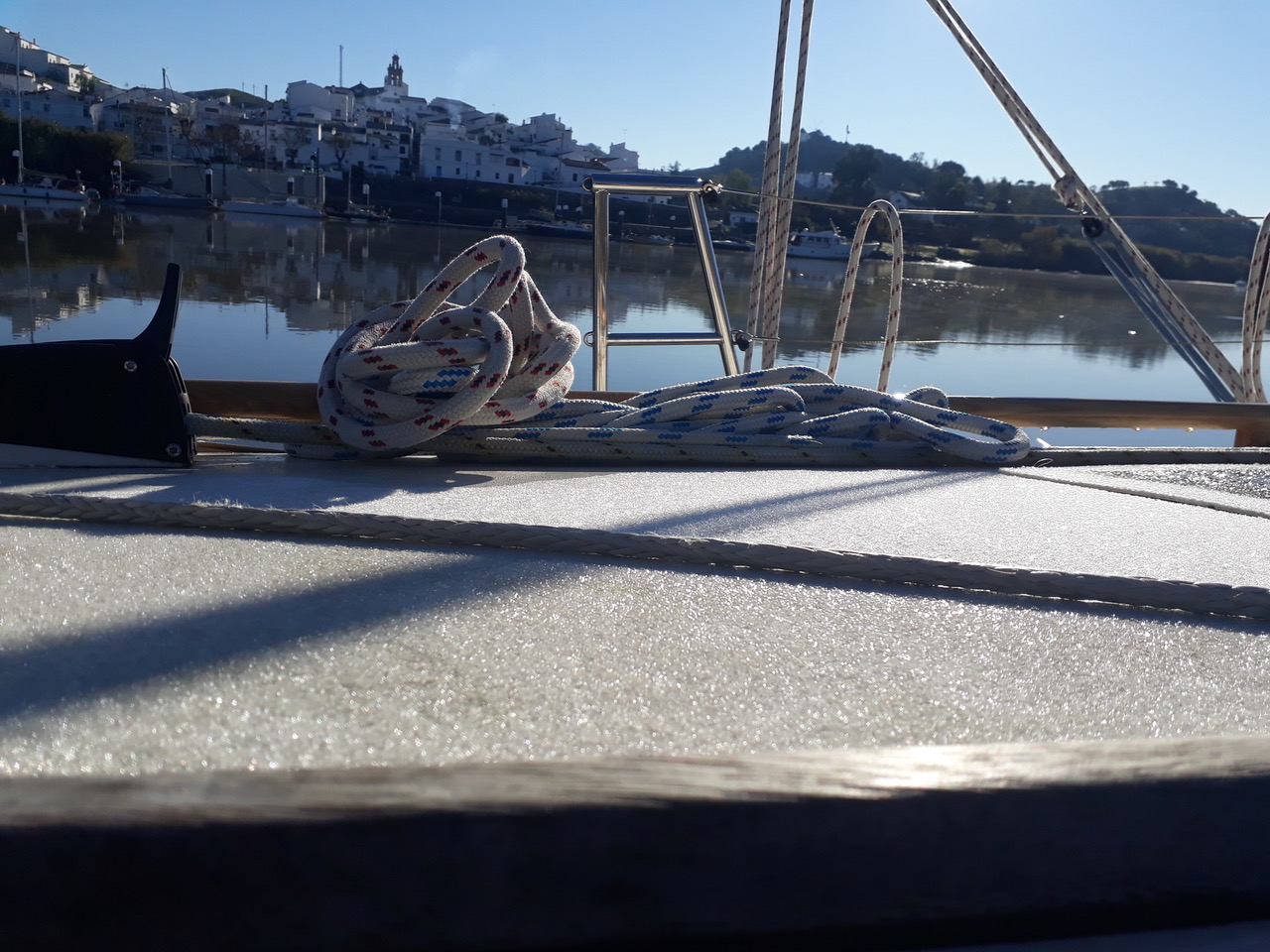
The secret of Ya keeping warm inside in wintertime is in three things:
- Insulation
- Insulation
- Insulation
1. Insulation – a lot, and neatly built in
Before we started with the carpentry, the hull of the Ya was insulated. This was done very precisely with high quality foam, called PIR foam (not PUR!). It is built up in layers up to 11 cm thick. Every foam plate is tightly closed to the other, with some caulk or PUR in between. So, there are no heat leaks.

Before and after the insulation: Tsjerk built the PIR foam up to a layer of 11 cm thick. As a real ships carpenter, he sealed all seams with great care, so, no heat can leak through and no condensation can occur.
2. Insulation – PIR as an affordable quality foam
How good is this PIR foam? Well, it is a great insulator and very affordable, and it is self-retardant, so it slows down fire. In the table below you see some numbers.
The Lambda number says how many Watts of heat goes through the material if it is 1 m thick and when there is 1 degree (Celsius or Kelvin) difference on each side. So, the lower the Lambda, the better the insulation. As you can see, the very expensive Vacuum Insulation is doing best. The PF Quod Core (0,015) is second best, but it can only be applied flat, and it is rather expensive. And the third best is PIR: this can be used on yachts. It is also self retarding. Materials like cork or expanded clay are doing much worse. Better not use them on yachts, they also weigh a lot.
On board of steel yachts, often glass wool is used. It is easy to put it neatly in any corner. But, once wet, it insulates only as good as the water in it. And it can go down and hang, a disadvantage. When it is dry, it insulates OK. But PIR does that better and PIR can’t take water (condensation). Disadvantage of PIR is that you need to work very precisely. Every open seam is a heat leak and that also creates condensation.
The final column in the table shows the resistance value (R-value). As the Lambda is a theoretical number, the R-value shows the effective heat resistance when the insulation is used in houses, caravans, boats. The higher the R-value, the better. It confirms that PIR is the best affordable choice.
| Material | Average Lambda | R-value for 100mm thickness |
| W/(m-K) | M2K/W at 100mm | |
| Brick (sand lime) | 0,8 | 0,125 |
| Glass fibre | 2,5 | |
| Core cell foam | 2,6 | |
| Glasswool | 0,036 | 2,63 |
| Rockwool | 0,036 | 2,6 |
| Cellulair glass | 0,044 | 2,78 |
| Expanded clay | 0,044 | 2 |
| Hay | 0,05 | 2 |
| Cork | 0,039 | 2,5 |
| EPS | 0,027 | 2,75 |
| XPS | 0,027 | 2,85 |
| UF | 0,043 | 2 |
| PUR | 0,027 | 2,6 |
| PIR | 0,021 | 4,4 |
| PF/ Quad Core | 0,015 | 5,56 |
| Vacuum Insulation | 0,0042 | 23,8 |
source: https://papagreen.org/tools/isolatiewaarden-in-lambda-rd-en-u-van-250-materialen/
3. Insulation – to get comfort
On Christmas night it was minus 3º Celsius. We were having a Corona-proof dinner with some fellow-sailors. It was nice, we had fun, lots of olives and almonds, little alcohol and no heater Then, our friends asked where our heater was. Well, somewhere packed deep down in a bilge; we can’t remember using it. Yet, the atmosphere on the Ya felt as comfortable as in a house, or even better. How is this possible?
Now, let us compare the insulation of the Ya with that of a normal house built in the 70’s or 80’s. How well is it insulated? Or, to put it technically: What is the heat resistance of the house’s walls and the Ya’s skin?
Suppose you live in a house with brick cavity walls and 5 cm of rockwool insulation. The two layers of 10 cm bricks each have an R-value of 0,125. So, this is 0,25 in total. 10 cm of rockwool has an R-value of 2,6. Your house has 5 cm, with an R-value of 1,3. So, for the house the total R-value is 1,3 + 0,25 = 1,55 which is the total heat resistance of your wall.

Here you see the intersections of the skin of the Ya and a cavity wall of a normal house. The heat resistance -the R Value – of the skin of the Ya is 3 to 4 times higher!
Now the Ya
The skin of the Ya is made of 6 mm of glassfibre, 20 mm of core-cell foam, then 4 mm of vinylester/glassfibre. In addition, on the inside the skin is covered with 110 mm PIR foam.
So, the skin has glassfibre (6mm +4 mm) 10 mm. The R-value of 10 cm is 2,5, so the R-value of 1 cm = 0,25. It also has core-cell foam 20 mm. The R-value of 10 cm is 2,6, so the R-value of 2 cm = 0,52. On the inside: PIR foam 110mm. The R-value of 10 cm PIR is 4,4, so the R-value of 110 mm = 4,84. So, for the Ya the total R-value is 0,25 + 0,52 + 4,84 = 5,61.
The total heat resistance of the skin of the Ya is more than 3 times higher compared to an insulated house. No miracle Ya keeps it warm inside in wintertime.

